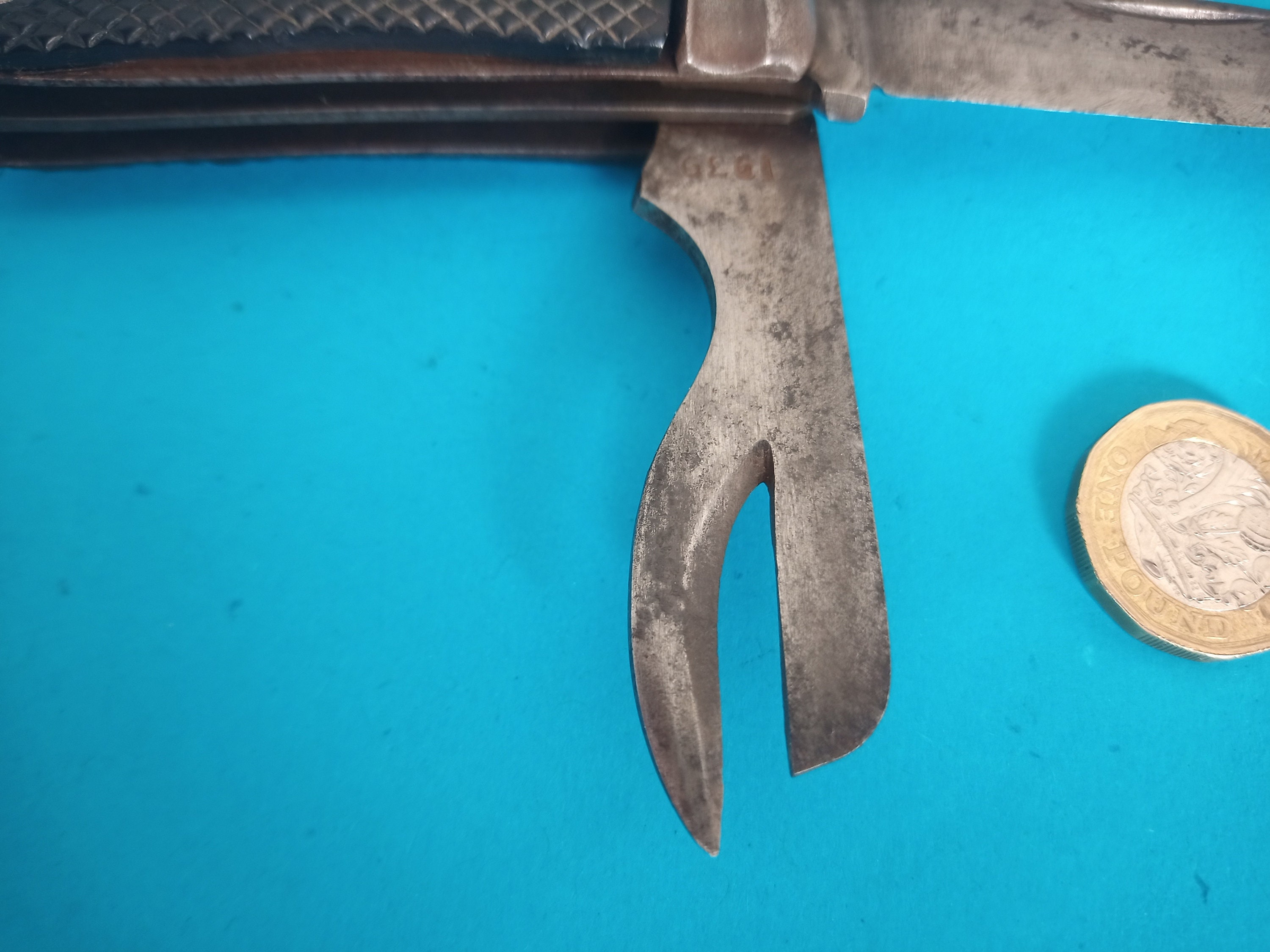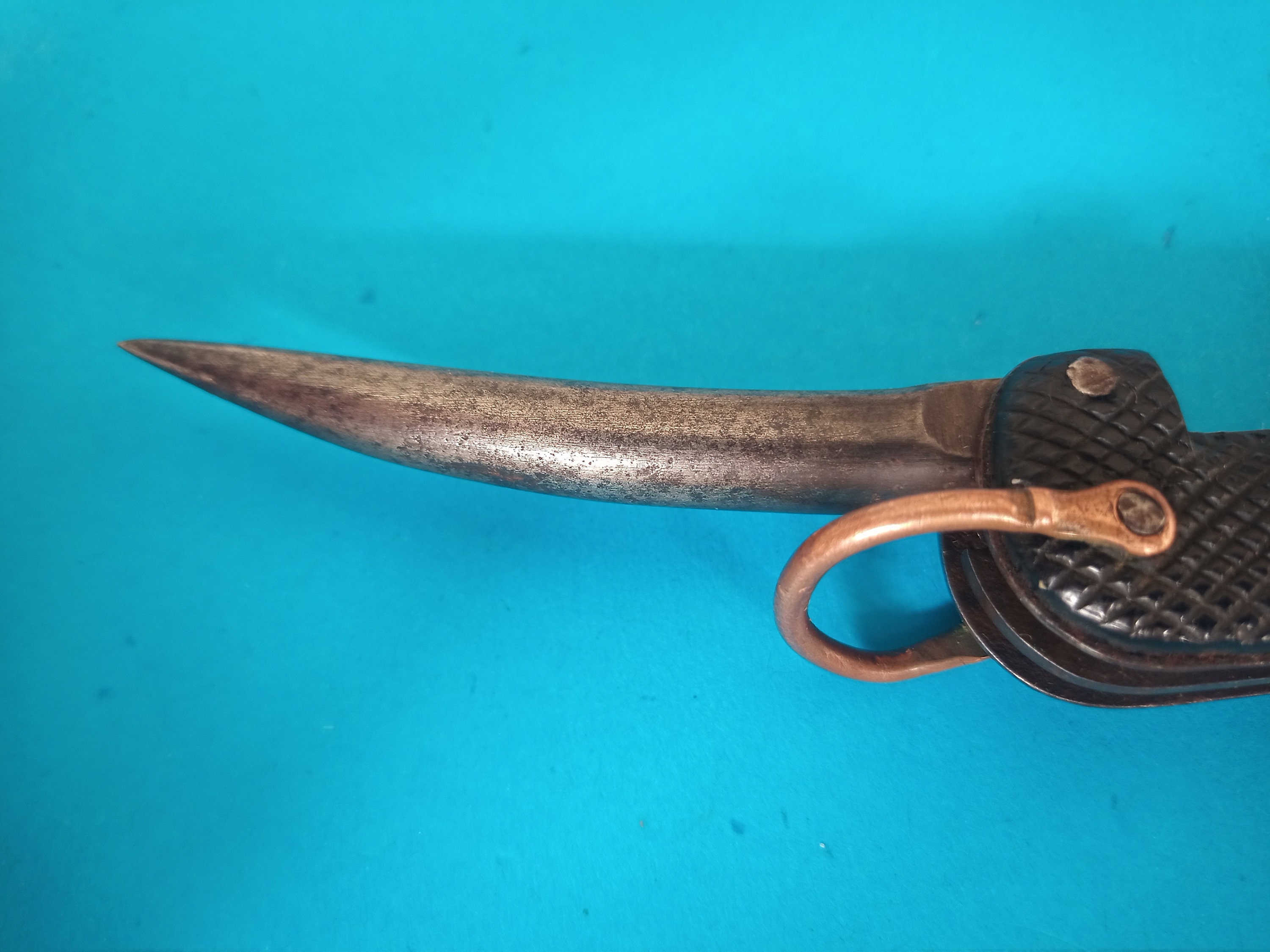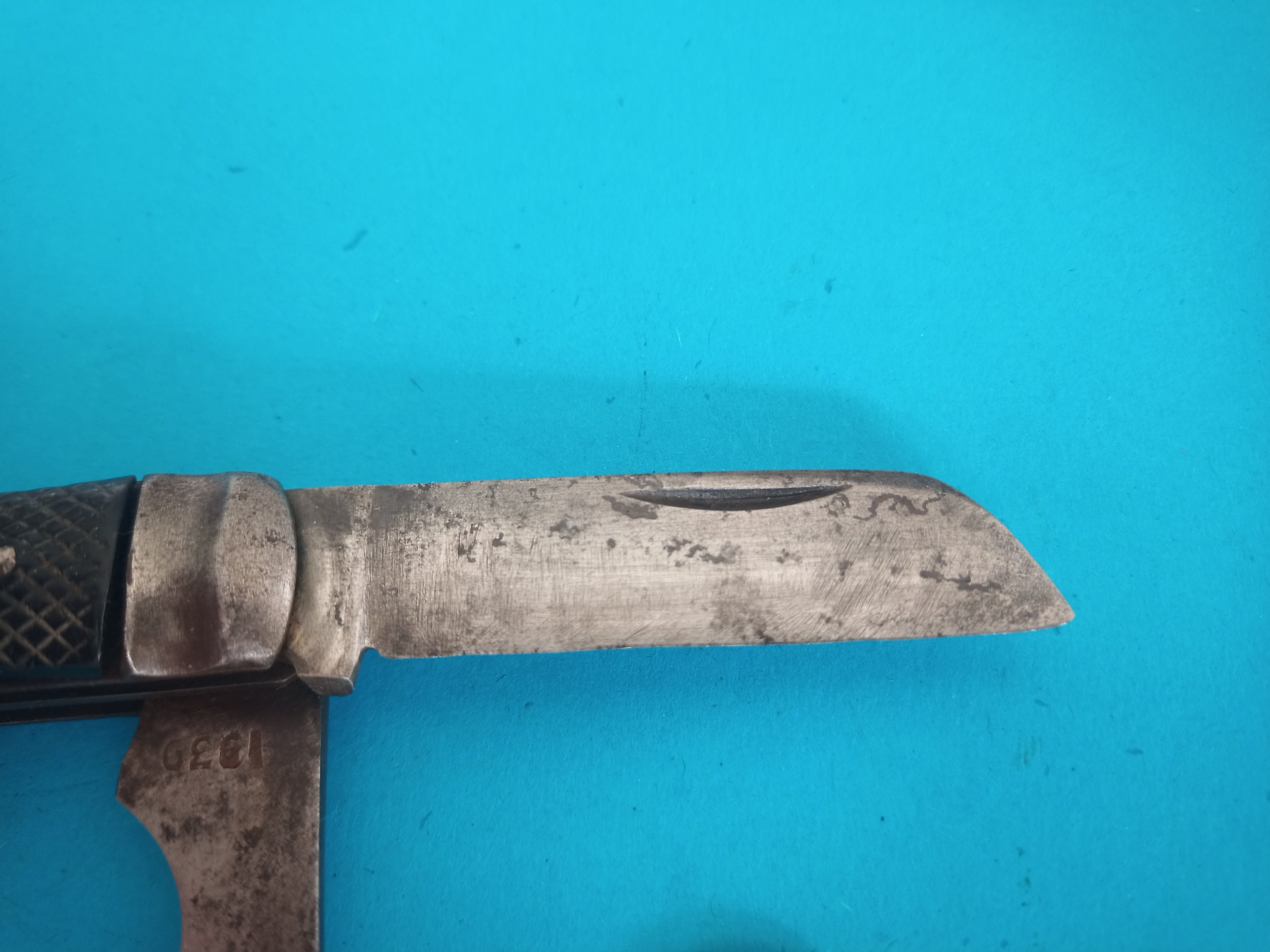Highlights










Description
Excellent condition Wade and Butcher jack knife (army) stamped 1939. 6 inches long with a 2.5 inch main blade. Tin opener is stamped Wade and Butcher, Sheffield, England, with the reverse stamped 1939. Marlin spike is stamped with the obligatory arrow! Everything snaps really nicely. Beautiful knife!
About Wade and Butcher:
William and Samuel Butcher were the sons of James Butcher, a cutler in Charles Street, and his wife, Ann. They were baptised at Queen Street Independent Chapel: William on 20 May 1791 and Samuel on 23 March 1795. James died in 1801. Little is known of his sonsu2019 early lives, though Samuel was apprenticed for seven years to Richard Nayler, a razor maker (Wallis, 1952-57). An establishment date of 1725 was claimed in later advertisements, but the partnership of William and Samuel did not begin until the next century. In 1819, William launched an edge tool manufactory on a small plot of land in Eyre Lane. In Sheffield General & Commercial Directory (1821), William placed a fold-out advertisement, which depicted the Eyre Lane premises (looking much as they are today). The emphasis was on tools ? especially for plantations in the West Indies and Brazil ? besides skates, saws, machetes, and cutlasses.
By 1822, as the small works expanded, William began melting crucible steel. Apparently, a friend gave William u00a3100 credit in cast steel to launch the business, with another backer offering the same (Sheffield Independent, 1 February 1873). In the local directory of 1822, William was listed as a manufacturer of edge tools and as a steel converter and refiner. Plane irons and chisels were another speciality, which have survived in some number in the hands of collectors and museums. They are often marked u2018W. BUTCHER. WARRANTED CAST STEELu2019.
Another firm appeared in the directories of 1821 and 1822 ? Wade & Butcher ? which traded from 85 Arundel Street (on the other side of the Eyre Lane block). The u2018Butcheru2019 is not identified, but it was presumably Samuel. The other principal was Robert Wade, who had been listed as a razor manufacturer in Arundel Street since 1816. Wade was possibly the son of Robert Wade (a maltster and corn factor, Church Lane) and his wife, Eleanor. St Paulu2019s baptismal register recorded the christening of Robert Wade (son of Robert) on 4 June 1773. Richard Wade (Wingfield, Rowbotham) may have been his brother. Robert the maltster may have died in 1794 (according to St Paulu2019s burial register); Eleanor died in 1848, aged 95. No information is available on the early career of Robert Wade, the son, but it is known that he was an officer in the local Volunteer militia. Wade & Butcher specialised in table knives and razors (and razor strops). When Wade started with Butcher, he had only two hearths for making razors (Sheffield Independent, 25 January 1873). After 1825, Wade & Butcher disappeared from Sheffield directories, probably because Robert Wade had died. An individual of that name, aged 54, was buried in St Paulu2019s churchyard on 8 December 1825, though no details appear to have been reported in the local press. The partnership with Butcher ended. In 1828, only Mrs Robert Wade was listed as a razor manufacturer in Arundel Street (in one directory, the listed name was Jane Wade). It was later reported that Mrs Robert Wade, the relict of Mr Wade of Arundel Street, had died at Whittington, near Sheffield, on 14 July 1829 (Sheffield Independent, 18 July 1829).
In 1826, William and Samuel launched Butcher, Brown & Butcher (with John Brown) at Eyre Lane and Charles Street. In 1830, that partnership was dissolved and henceforth the firm became u2018William and Samuel Butcheru2019, or more simply u2018W. & S. Butcheru2019. Between the 1830s and 1850s, the business expanded steadily, as the Butchers acquired additional steel-making capacity, workshops, warehouses, and steam grinding wheels in Furnival Street and Eyre Lane. In the 1840s, the brothers also invested in tilting, rolling, and forging capacity at Philadelphia Steel Works, Neepsend, which was close to the River Don.
Samuel began visiting the USA as early as 1823. In 1827, he was listed as a merchant in Maiden Lane in New Yorku2019s hardware district at the southern end of Manhattan (now part of the financial district). In New York in 1825, Samuel had married Rosa Bliss (1806-1832), the young daughter of Captain Theodore Bliss. By 1837, W. & S. Butcher had an office in Platt Street as a seller of Sheffield hardware. By the 1850s, Butcheru2019s had a Boston agency and traded with retailers in New Orleans, Chicago, and San Francisco. u2018Wade & Butcheru2019 became one of the best-known razor brands in America. u2018So great was the fame of this firm that many people speak of all old Sheffield razors as Wade & Butchersu2019 (Lummus, 1922). William and Samuel also catered for the American demand for Bowie knives (Adams et al, 1990).
Intriguingly, in about 1842 W. & S. Butcher opened a Philadelphia office, which was headed by Robert Wade (1819-1887). Wade came from Sheffield and was almost certainly the son of Robert Wade in Arundel Street. In 1819, the register of St Peteru2019s parish church recorded the baptism of Robert Wade ? the son of Robert Wade, a razor manufacturer, and his wife, Jane. Robert had been born on 6 August 1819. Wade prospered in America, presumably under the Butchersu2019 tutelage. In 1845 in Philadelphia, he married Charlotte Bourne nu00e9e Swett, who was connected to a prominent Massachusetts medical and mercantile family. His wife must have died by 1860, because by then Wade had re-married. His second wife was Mary Ann (1820-1899), the daughter of Sylvester Reed. They lived in Rittenhouse Square, amongst the well-to-do in Philadelphia. Wadeu2019s portrait and Maryu2019s were reproduced in Charles T. Cohen, Rittenhouse Square: Past and Present (1922). After the Civil War, Wade moved to New York and in the 1860s was running Butcheru2019s agency in Beekman Street. In 1868, he was listed in Wilsonu2019s New York City Copartnership Directory as the Butchersu2019 agent alongside Francis Speir. In the US Census (1870), Wade was a u2018hardware dealeru2019 living in Brooklyn, with Mary and their family (they apparently had four daughters). By 1880, when he resided in Englewood, New Jersey, Wade had apparently retired. He died in New York on 19 March 1887 and was buried at Brookside Cemetery, Englewood, New Jersey.
By the 1850s, W. & S. Butcher was one of the most important manufacturers in Sheffield. The firm was recognised as a specialist in edge tools, files, and razors, besides pocket cutlery, scissors, and Bowie knives. In the 1850s, apparently about 500 workers were employed. Reports in the local press placed Butcheru2019s as the leading u2018sundryu2019 edge tool maker (based on the number of hearths) and second only to Turton of Sheaf Works in its production facilities for files (Sheffield Independent, 2 October 1852). One industrial correspondent (Burn 1852), reported that Butcheru2019s had 32 forgers in the edge-tool department, who could produce a gross to one-and-a-half gross of tools per day. This was besides u2018fifty-seven thousand six hundred depilatory instruments [razors] annually!u2019 At the Great Exhibition in London 1851, Butcheru2019s garnered a Prize Medal for files and razors (The Illustrated Exhibitor, No. 12, 23 August 1851).
Most of these products were manufactured by hand. The Butchersu2019 attempt to mechanise production encountered opposition from trade unions. After one protracted dispute in 1850, William Butcher and his wife were awoken at 2.00am one Sunday morning by an exploding can of gunpowder, which had been tossed onto the balcony of their bedroom (Sheffield Independent, 6 April 1850). In 1852, William had tried to install an American file-cutting machine, but for some reason the u00a315,000 trial was abandoned. In 1866, the firm was also involved in a major battle in the file trades, when workers objected to the introduction of machines for grinding and cutting files. For the Butchers, it was an eventful decade. The Sheffield Flood in 1864 seriously damaged its Philadelphia Steel Works.
William and Samuel became part of the townu2019s social elite. William was elected Master Cutler in 1845. He was also a Town Trustee and Town Collector. Meanwhile, Samuel held a string of public offices, including Mayor (in the same year in which William became Master Cutler), Alderman, Church Burgess, and JP. The brothers were among the richest individuals in Sheffield. William lived at Five Oaks mansion in Glossop Road. In the 1860s, Samuel ? who was more genial and out-going than his elder brother ? lived at Banner Cross Hall. This was a big mansion on Ecclesall Road, where Samuel lived in some comfort. His household had eight servants and a cellar of wines u2018too well known to require commentu2019 (Sheffield Independent, 16 April 1870).
However, by then the company had begun to contract. After the Civil War, America developed its own steel and tool industry and the demand for Sheffield imports fell drastically. In the 1860s, age caught up with the brothers. Samuel was in retirement when he died on 1 December 1869, aged 74, at Banner Cross Hall. He was buried in the family vault in Ecclesall churchyard. It was a largely private funeral. His brother was too enfeebled to attend. An oil portrait of William (unveiled at the Town Hall only weeks before his brotheru2019s death) had been completed by the artist H.F. Crighton only with difficulty. William died on 8 November 1870, aged 79, at his home Five Oaks. He was buried in Ecclesall within yards of Samuel. Robert Wade attended the funeral. Williamu2019s grave is surmounted by an impressive granite cross. Many of their assets were sold, including Philadelphia Steel Works. Samuelu2019s property at Banner Cross Hall was auctioned, with his wine collection heading the list of saleable items (Sheffield Independent, 23 April 1870). The brothers had amassed considerable wealth: they each left nearly u00a3100,000.
Williamu2019s two daughters survived him (one of whom, Rosa Elizabeth, married J. E. Cutler), but he had no son and heir to assume the business. Samuelu2019s American wife, Rosa, had died in Sheffield on 3 December 1832, aged 25. He had two daughters from this marriage. In 1835, he married Maria nu00e9e Fosbery at Edgbaston, near Birmingham. His sons from this marriage included William Jun., who had been born in 1836. In the early 1860s, William Jun. launched a venture at Rutland Works, Neepsend, to exploit the growing market for steel railway wheels. In 1863, it was bankrupt with over u00a323,000 debts. The firm was bailed out by Samuel and continued to trade as S. Butcher & Co (in partnership with Rotherham ironfounder, Joseph Armstrong) until the late 1860s. William Jun. next tried his luck in America, but his attempt in Philadelphia to launch another steel castings business was likewise a failure. It was left to another of Samuelu2019s sons ? Charles Fosbery Butcher (1841-1924) ? to take over the Arundel Street/Eyre Lane business in 1872.
Under Charles F. Butcher, Butcheru2019s continued to export cutlery and tools to the USA. However, competition from American manufacturers was growing and exports had to surmount rising US tariff barriers. After 1872, Butcheru2019s ceased holding extensive stocks in New York and began selling through American agencies, especially those run by German immigrants. Chief amongst these was A. Kastor & Bros, which had been launched in New York in the 1880s by Adolph Kastor (1856-1946). The latter began making annual trips to Sheffield after 1879, so that he could buy cutlery at favourable rates. Kastor was particularly interested in selling cutlery that still sold in volume in the USA ? notably razors that had not yet succumbed to machine production. Kastor was soon stocking Wade & Butcher razors. At the time, the Wade & Butcher premises occupied a separate site on Eyre Lane/Brown Lane ? directly opposite the main Arundel Street complex. Kastor also reached agreements with Sheffield firms Joseph Allen and Joseph Wostenholme, and also with a local cutlery merchant, Alfred Williams.
In 1913, one of Adolphu2019s brothers ? Sigmund Kastor (1866-1947) ? decided to buy the controlling interest in Butcheru2019s. Besides Sigmund, the partners included Charles Leslie Butcher (C. F. Butcheru2019s son, who had been born in 1877) and Alfred Williams. Sigmund probably intended to continue to ship razors from Sheffield to the USA, but this arrangement was inevitably disrupted by the War. In 1918, Sigmund sold the business. Butcheru2019s soon had another American suitor. This was the Durham-Duplex Razor Co Ltd, which was a New Jersey pioneer of safety razors ? a product that would largely supersede hand-ground straight razors in the early twentieth century. The firm had been established by Thomas C. Durham and was later headed by Thomas C. Sheehan (1870-1938). In 1920, Sheehan visited Sheffield after Durham-Duplex had acquired shares in W. & S. Butcher. In the following year, the US firm registered Wade & Butcher Ltd as a new company in England, with u00a31,000 capital (and Wade & Butcher Corporation was registered in the USA, with capital of $1m). By the end of the decade, Durham-Duplex held the majority of Butcheru2019s stock and the old family interest waned. On 10 January 1924, Charles F. Butcher died at West Lodge, Claremont Place, Sheffield, leaving u00a3125,950. Despite the takeover, W. & S. Butcher Ltd continued to be listed in directories as a cutlery manufacturer in Eyre Lane and 72 Arundel Street. u2018Alfred Williamsu2019 was another stand-alone name in Eyre Lane.
Initially, the Sheffield plant only manufactured the razor holders for Durham-Duplexu2019s blades, but later the factory was set up to operate independently. In 1923, Sheehan visited Sheffield again to implement plans to replace the older craft methods with American-style mechanisation. By 1924, production was underway, but whether Sheehanu2019s plans proceeded very far is unknown. Possibly, many Wade & Butcher blades were made in New Jersey, not Sheffield. Sheehan also had plans to launch a line of stainless steel knives. In an article in The American Cutler (April 1922), he claimed that his company made the best stainless steel cutlery on the market. His machines could grind at the u2018hardly believableu2019 rate of 24 blades at once, in a factory so clean that workers could grind in their u2018dress suitsu2019. In the early 1920s, one result of this involvement in stainless cutlery was Wade & Butcheru2019s production of rugged American-style hunting knives, mainly for sale in the USA. The Wade & Butcher u2018TEDDYu2019 was the first stainless steel hunting knife on the market. The u2018BOONEu2019 was the carbon steel equivalent; and some knives carried the names u2018PIONEERu2019 and MANITOUu2019. The blades were stamped u2018Wade & Butcher, Sheffield, Englandu2019, which suggests that they were shipped from Sheffield (though it has also been remarked that they may have been made or assembled in America).
However, Durham-Duplex failed to capitalise on the mass market for safety razors. It faced competition from the industry leader Gillette and was also hit by the Depression. Moreover, the Arundel Street/Eyre Lane factory, with its numerous workshops and old forges, was probably not the best setting for a modern, mechanised plant. Sheehan to Sheffield in 1930, but seven years later he retired. He died at Montclair, New Jersey, in 1938, aged 68. In 1946, Alfred Williams died.
The last Butcher chairman was Talbot Dearden, who in 1950 changed the company name to BD Properties. It appears that the factory land was now worth more than the cutlery assets, which were sold. The Butcher and Wade & Butcher trade names/marks remained in the hands of Durham-Duplex, which at the start of the 1960s still listed u2018W. & S. Butcher Ltdu2019 in directories (though the address had changed to Petre Street, where Durham-Duplex was based). The names then faded away. In the late 1980s, u2018TO LETu2019 notices had sprouted on Butcher Worksu2019 grimy exterior. The factory had long been home to a variety of small businesses and some workshops continued to be occupied until about 2000. But eventually 72 Arundel Street fell silent and its future became uncertain. However, the city authorities chose Butcher Works for a showpiece restoration. Industrial archaeologists from Sheffield University first surveyed the building. After clearing the accumulated dirt and debris of many decades, they found a hand forge with the original anvil, leather bellows, and wooden quenching barrel. A grinding hull with the wooden housing for the grindstones was also largely intact. So, too, was the original sanitation (Jessop, 2016). By 2007, a u00a33 million grant had transformed the old factory into new offices, shops, and apartments.